WHO WE ARE
Our Insights
Articles


The State of Latinas in Corporate America draws heavily on Lean In and McKinsey & Company’s annual Women in the Workplace study. Since 2015, more than 590 companies employing more than 22 million people, along with a quarter of a million individual employees, have participated in Women in the Workplace. To our knowledge, this makes it the largest study on the state of women—and Latinas in particular—in corporate America. This report primarily highlights data from the 2019–2023 Women in the Workplace studies. It also draws on an analysis of in-depth interviews conducted between 2021 and 2024 with more than two dozen Latinas; the findings from this analysis are featured in the “Beyond the Numbers” report sections.1 A brain trust of external experts on Latinas’ workplace experiences—in addition to an internal team of Lean In employees who identify as Latina—were consulted in the writing of the report.

INTRODUCTION
Latinas lose the most ground across the corporate pipeline
The last five years of Lean In’s research on the state of women at work reveal a disturbing trend: Latinas face the steepest climb up the corporate ladder and endup the most underrepresented of all groups of employees in the C-suite. Despite this reality, they remain highly ambitious and increasingly committed to advancing.This report offers an in-depth look at the distinct, compounding obstacles Latinas face at work. It also provides specific actions companies should take to ensureLatinas are given equal opportunities to grow, develop, and lead their organizations into the future.
PART 1
Latinas face the biggest drop in representation from entry level to the C-suite
Latinas start—and end—their careers significantly underrepresentedLatinas enter the corporate workforce at a disadvantage.There are roughly half as many Latinas at the entry level as in the general population: Latinas make up over 9percent of the population but just under 5 percent of entry-level workers.2 This scarcity of Latinas at the entry level makes them the most underrepresented of any group of women at the beginning of their careers.3From there, Latinas face the steepest climb up the corporate ladder—or the biggest drop in representation from entry level to the C-suite.4 As a result, they end up the least represented at the top: only 1 percent of C-suite executives are Latina.If this trend continues, Latinas will not be able to catch up to other groups of women—let alone men—in leadership roles and will remain the most underrepresented group at the highest levels of corporate America.
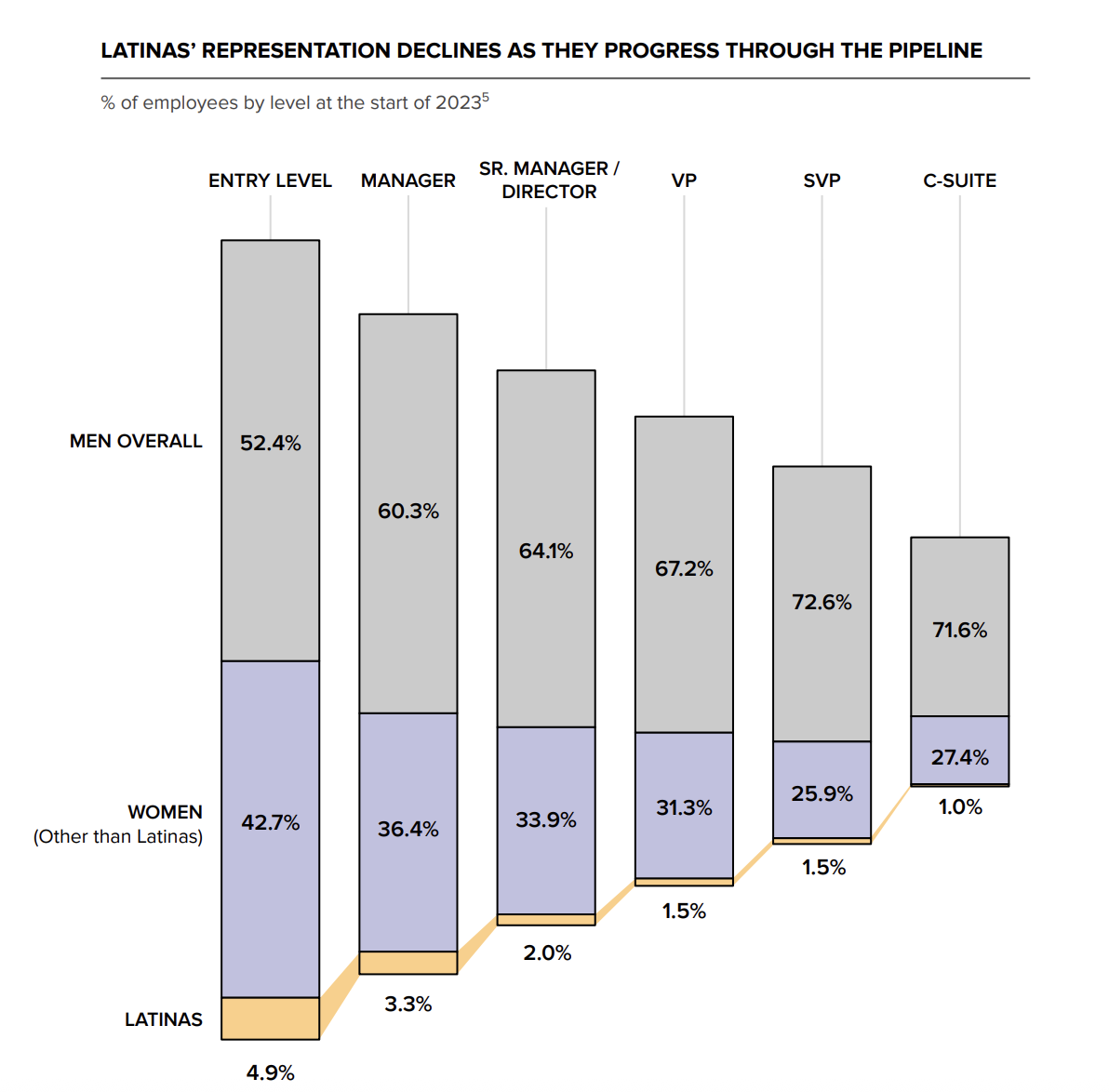
Latinas lose the most ground from the beginning to the end of the pipeline
Between the entry level and the C-suite, white men’s representation increases by 64 percent while Latinas’ decreases by 78 percent—the most of any group.
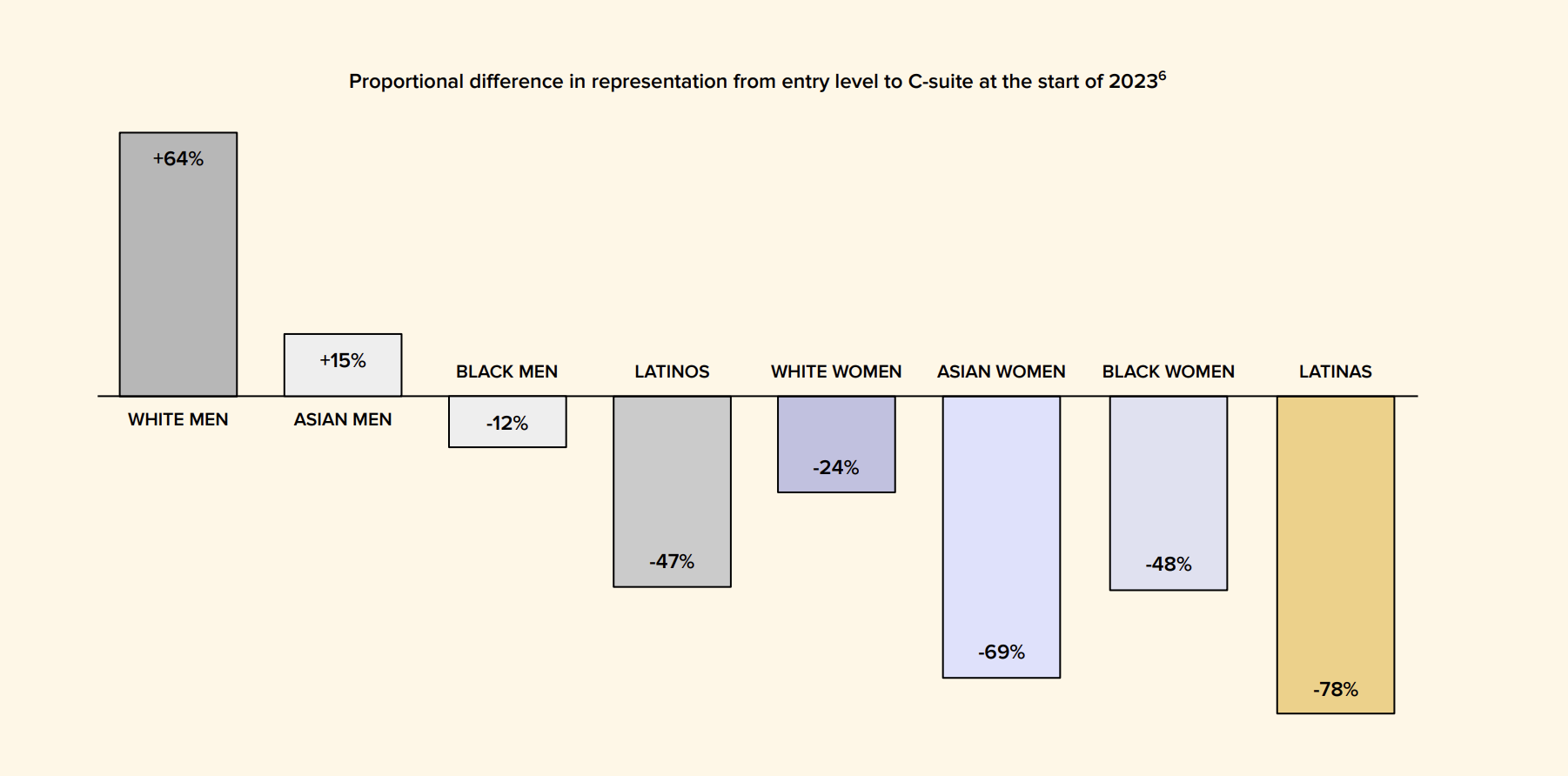
Latinas experience a broken rung atthe initial step up to manager
As Latinas move through a challenging corporate pipeline, they are particularly overlooked at two points. Alongside Black women, they experience the most significant “broken rung” at the critical initial step up to management. For every 100 men promoted from entry level to manager, only 74 Latinas are promoted. As a result, there are far fewer Latinas to promote at every subsequent level and their representation dwindles from there.
Latinas are not to blame for the broken rung.Entry-level Latinas ask for promotions as often as men do. They are also no more likely to leavetheir companies: in 2023, 16% of entry-levelLatinas chose to leave, compared to 17% of men at the same level.7

A second hurdle stands in Latinas’ way just when the C-suite is within reach
Later, at the critical step into senior leadership, Latinas face another barrier: alongside Asian women, Latinas have the lowest promotion rates of any group of women from director to VP. For every 100 men promoted toVP, 90 Latinas are promoted. This holds Latinas back at a key moment when the C-suite is finally in view.Together, these two obstacles—the first preventing Latinas from entering management and the second preventing them from entering senior leadership—make it nearly impossible for Latinas to gain ground at the highest levels of corporate America.

Latinas in the U.S. experience the widest pay gap
Across the entire U.S. workforce, Latinas experience the largest pay gap of any group of women: they earn a mere 52 cents for every dollar a non-Hispanic white man earns.10This pay gap is often largely attributed to Latinas working in jobs and industries that pay less.11But even within corporate America, there are signs that the pay gap remains the widest forLatinas: an analysis of U.S. census data shows that Latinas working in business and finance earn 36 percent less than white men—the least of any group of employees.12Our Women in the Workplace data also reveal inequalities in pay. Despite historically asking for raises just as often as other women, Latinas are less likely to receive them. For example, only 1 in 4 reported receiving a raise in 2023, compared to 1 in 3 women overall.13
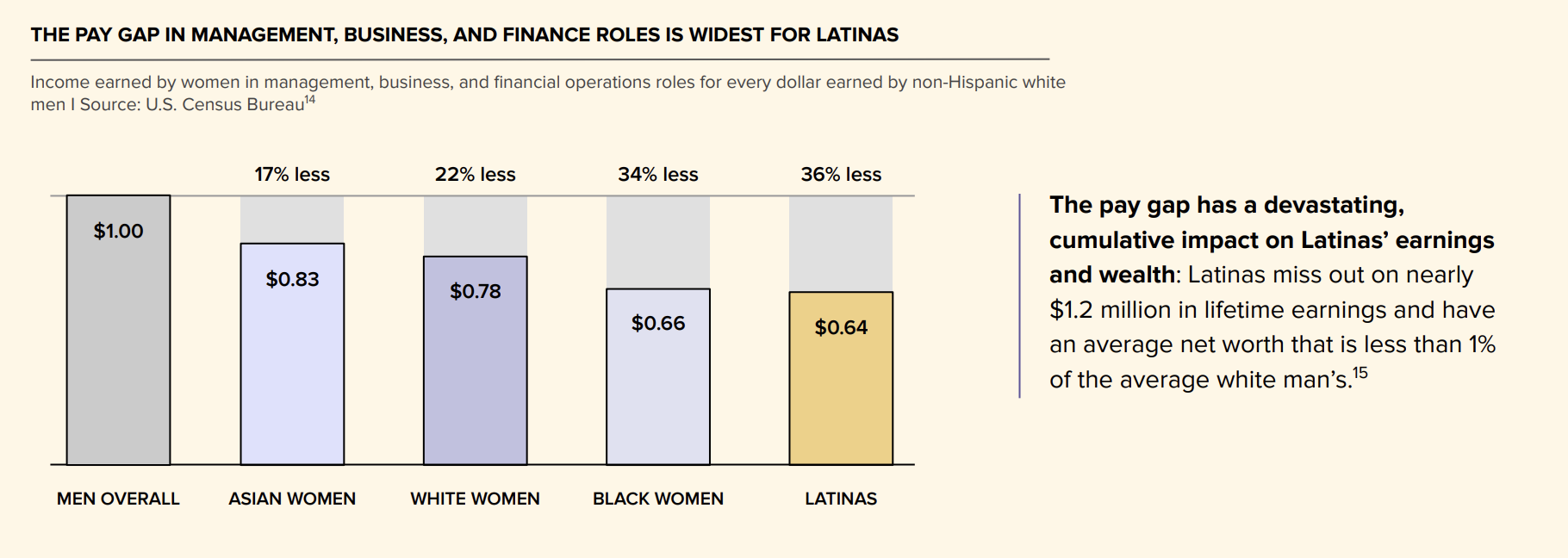
From 50 Ways to Fight Bias | How employees can help combat biases women face at work
Performance bias harms Latinas’ advancement
HOW IT CAN SHOW UP AT WORK
In a meeting about promotions, a colleague questions whether a Latina employee has the skills for a manager role.
THE BIAS BEHIND IT
Performance bias is based on deeply rooted—and incorrect—assumptions about people’s abilities. For example, women are often stereotyped as less competent than men, and Latino/a people tend to bestereotyped as less skilled than white people. Latinas face a compounding version of these biases, which makes it harder for them to get hired and promoted.16
WHAT YOU CAN DO
Start by asking your colleague for concrete examples of why they don’t think your Latina coworker has the right skills. If your colleague doesn’t offer enough evidence, you can say something like, “It sounds as though she has the skills that she needs to me.” You can also check her skill set against the list of criteria for the promotion. If she meets all or most of those listed, that can help settle the matter. And if there aren’t clear criteria in place, you can recommend the team spends time establishing specific requirements for the role, which will help minimize subjective judgments about who should be promoted.Go to Lean In’s 50 Ways to Fight Bias Program to learn more.

PART 2
Latinas remain highly ambitious despite getting less support to advance
Latinas are motivated to reach the top
Latinas remain ambitious despite their low representation across the pipeline. In fact, Latinas remain deeply motivated to ascend the corporate ranks: they are more interested in being promoted to the next level and in becoming senior leaders than white women and women overall. These ambitions are also growing at an outsized rate: Latinas are more likely to say that advancement has increased in importance to them in recent years.
Latina job seekers also prioritize career advancement. When considering moving to a new employer or leaving their current one, a third of Latinas say that the ability to get promoted matters most to them, compared to a fourth of white women.18
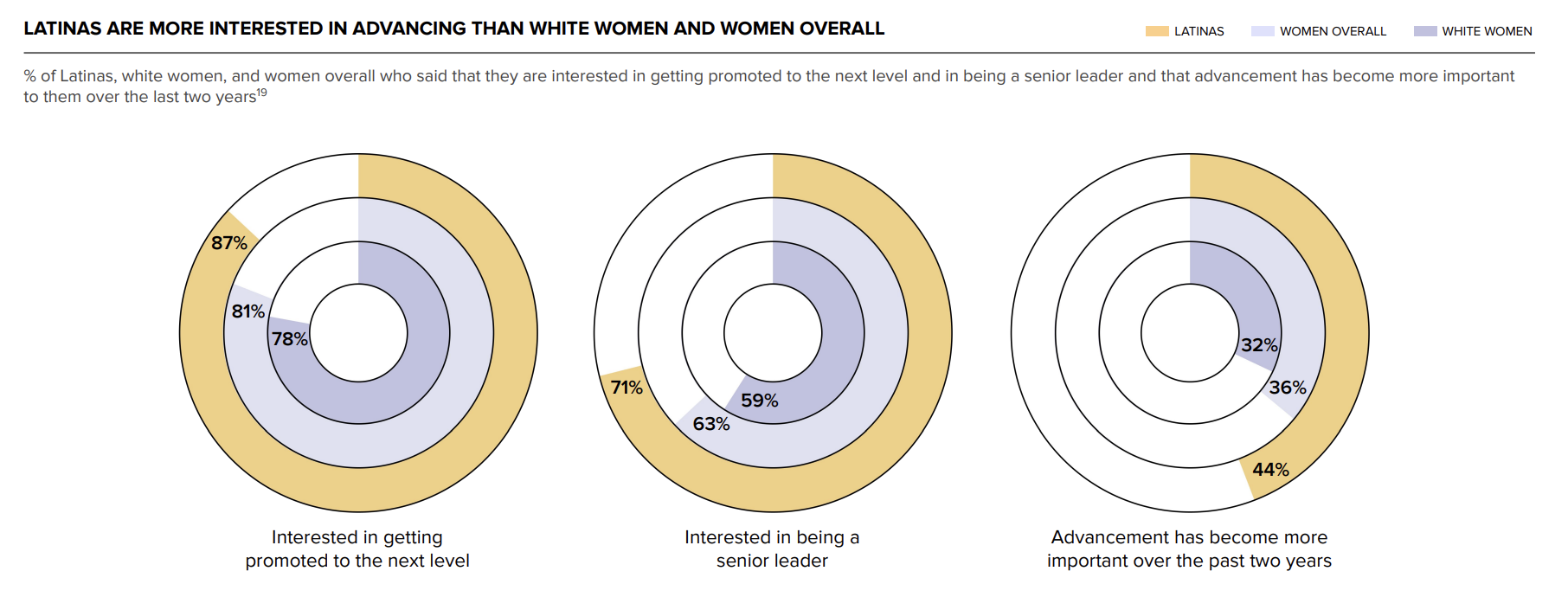
BEYOND THE NUMBERS
Latinas’ strong ambitions can go unrecognized in the workplaceLatinas’ high ambitions are underpinned by Hispanic cultural norms that emphasize a strong work ethic and company loyalty. 20 As one Latina shared, “Latino culture really does teach you how to work hard—to come in first, stay the latest, and really accomplish more.”But other cultural norms—particularly those around gratitude and “keeping one’s head down” at work—can make it harder for Latinas to engage in workplace behaviors important to getting ahead, including promoting their accomplishments and vocalizing their desires to advance. To get ahead at work, one Latina explained, “you have to brag about yourself.You have to sell yourself. You have to put yourself out there.”Yet these actions often feel inauthentic to many Latinas.Understanding these cultural norms—and not mistaking them for a lack of ambition or drive—is important for companies committed to retaining and advancing Latinas.21

A lack of support makes it harder for Latinas to get ahead
Despite being ambitious, Latinas receive less of the encouragement and recognition critical to getting ahead at work. Latinas are less likely to have senior colleagues advocate for them and celebrate their accomplishments.Manager support is also crucial to advancement, yet Latinas are less likely to have their managers invest in them professionally.22 They are also less likely to say that their managers ensure they get credit for their work and show interest in their career advancement.
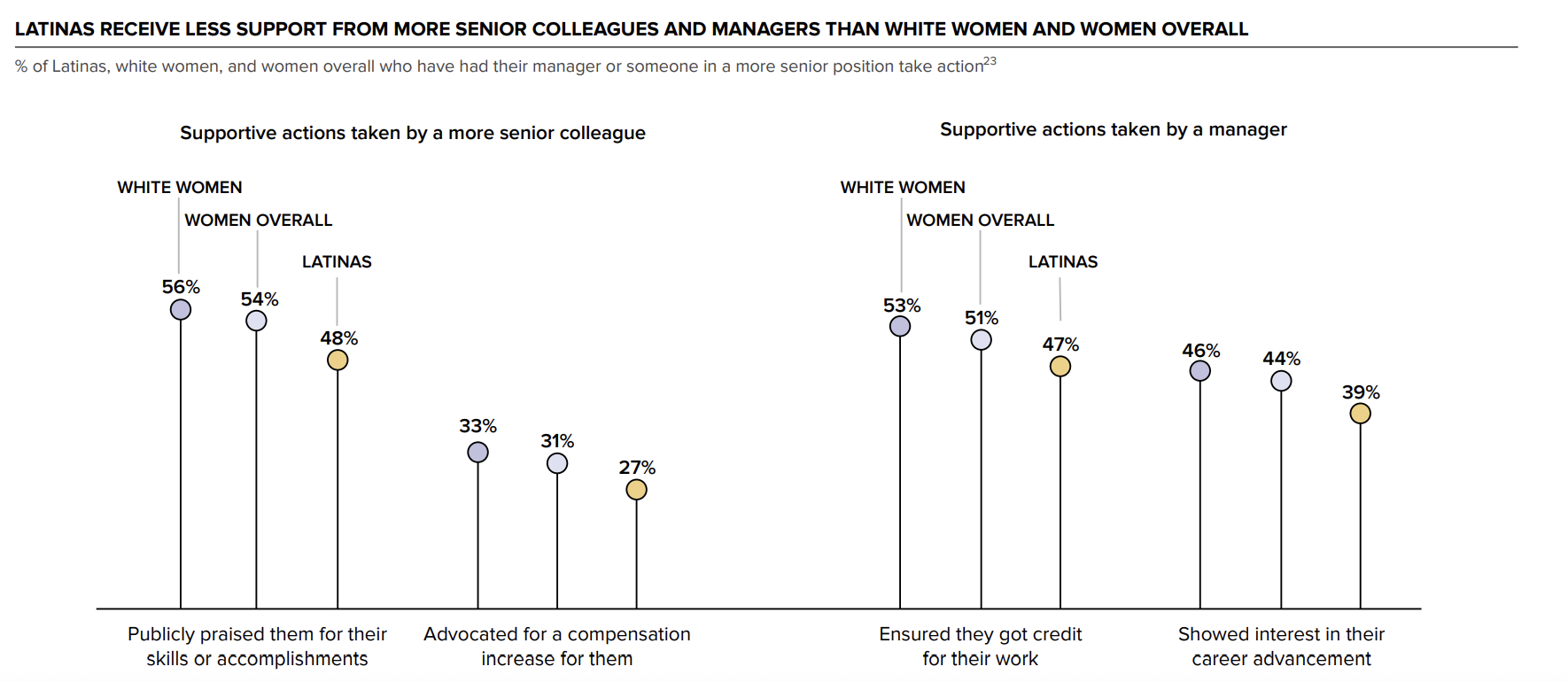
BEYOND THE NUMBERS
Affinity bias makes sponsorship challenging for LatinasSponsorship helps drive career advancement. But throughout their careers, Latinas often miss out on sponsorship opportunities.24 Because leaders are more likely to sponsor junior colleagues with shared identities—due to what social scientists call “affinity bias”—a scarcity of Latinas in leadership decreasesLatinas’ likelihood of finding sponsors and has a negative impact on their rate of advancement.25 “I wanted a Latina executive who could serve as a mentor, coach, [or] sponsor to me,” shares oneLatina. “I looked within my own company and couldn’t find it.”26The few Latinas who make it to the top also face increased pressure to be the sponsors they never had. “I wanted to open the door for other women, especially Latina women, who would want to climb the ladder,” shared one woman who was the firstLatina at her company to become executive director. Yet such efforts are not always recognized. As a result, while serving as a sponsor can feel rewarding to Latinas, the pressure to do so can also be an additional burden for those already navigating a challenging climb up the corporate ladder.


Working flexibly is often not an option for Latinas Workplace flexibility can support employees’ ambitions: a majority of women and men who work flexibly point to greater productivity and feeling less tired and burned out as primary benefits.29 Yet Latinas have less access to flexibility than most. They are less able to choose where and when they work or take time away from their job to deal with life events.
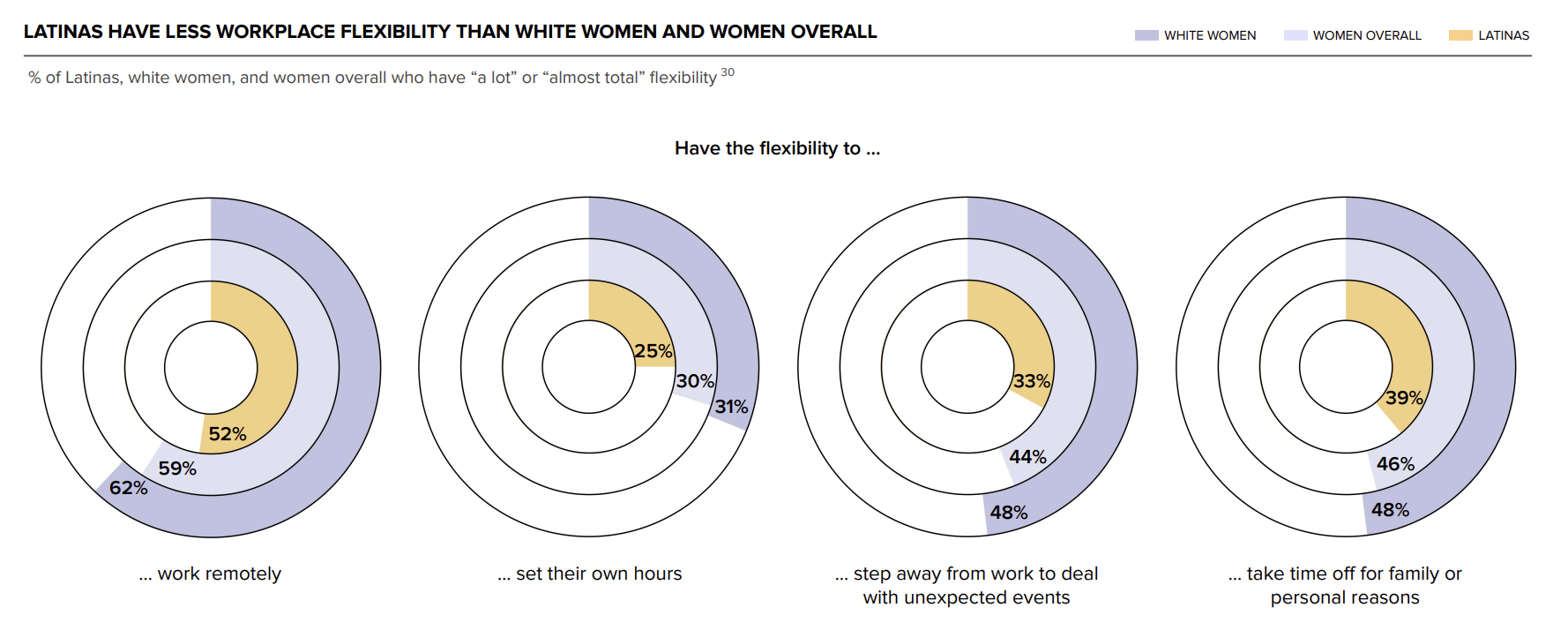
Manager actions further limit Latinas’ workplace flexibility
Even when Latinas have flexibility, they don’t always feel they can use it: only 1 in 4 say it’s “no big deal” to take advantage of opportunities to work flexibly compared to 1 in 3 women overall.31Manager actions may contribute to this sentiment. Latinas are less likely to say that their manager focuses on results rather than where and when work gets done. And fewer Latinas have managers who trust them to get their work done without micromanaging. Unsurprisingly, Latinas who are micromanaged by their managers also report having the least amount of flexibility.32
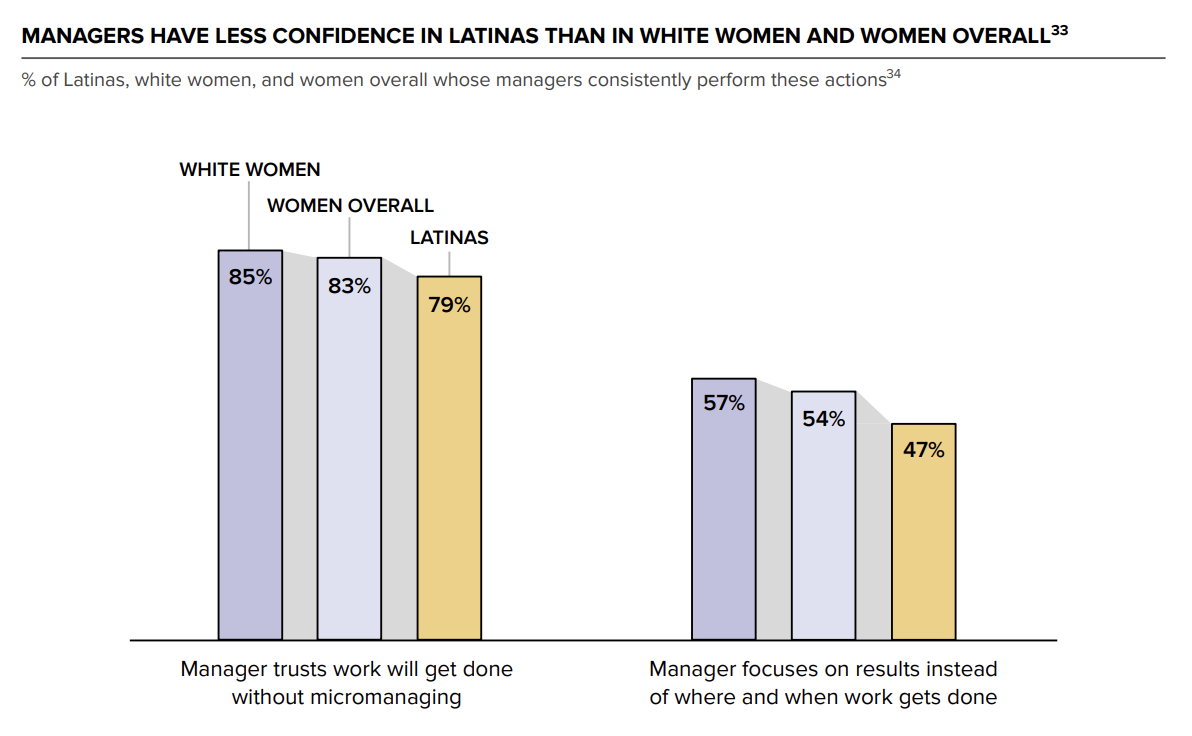
BEYOND THE NUMBERS
In the face of obstacles,Latinas remain highly committed to work and familyFor working Latinas, the importance of family within Hispanic culture can be both an asset and a challenge. On the one hand, family often serves as a source of professional strength.35 Latinas’ extended families provide critical support at home that allows them to put in the time and effort to get recognized at work.“There’s no way that I could have done this without my family,”shares one Latina director about her ascent up the corporate ladder while raising children. “My sisters dropped off my laundry and my mom dropped off food. They saved me time because they knew that’s what I didn’t have.”On the other hand, a strong cultural focus on family can also create additional responsibilities: compared to white women,Latinas spend more daily hours on housework and caregiving and are more likely to be on “double duty”—or caring for children and an adult, such as an elderly family member.36 “A lot of us play really large roles in our family that we can’t necessarily drop,” oneLatina explains, “but we also need to work to have a roof over our heads and put food in our mouths.” Because of this, Latinas share that workplace flexibility—and manager support for that flexibility—is critical to achieve their ambitions.37

From 50 Ways to Fight Bias | How employees can help combat biases women face at work
Maternal bias can hurt Latinas at work
HOW IT CAN SHOW UP AT WORK
In a meeting about hiring for a senior role that requires travel, a coworker questions whether a Latina would want to be away from her family that much.
THE BIAS BEHIND IT
Because Latinas are often perceived as highly committed to their families, coworkers can mistakenly assume that when Latinas have children, they will be less committed to their careers. This is a form of “maternal bias”—or the belief that mothers are less devoted to their jobs than non-mothers. Maternal bias can lead managers to assume a Latina isn’t up for a challenging assignment or traveling for work. This can result in Latinas getting unintentionally passed over for important advancement opportunities.38
WHAT YOU CAN DO
Ask the coworker who made the comment, “What makes you think that?” A probing question like this can help people see their biased thinking. You can also explain that Latinas often experience judgments of this kind, as they tend to be stereotyped as less career-oriented.39 Or you can recommend asking all of the candidates for the role how they feel about the travel requirements and let them speak for themselves.
Go to Lean In’s 50 Ways to Fight Bias Program to learn more.
PART 4
Latina Onlys face more microaggressions at work
Latinas are more likely to be “Onlys”—often the only or one of the only people withtheir racial identity in the room at work.40 Thirty-seven percent of Latinas say they are Onlys, compared to 13 percent of women overall.41 And Latina Onlys have profoundlymore difficult workplace experiences.Latina Onlys encounter more microaggressions: 74 percent have experienced microaggressions at work compared to 58 percent of women overall.42 In particular,Latina Onlys are more than twice as likely to have a coworker express surprise at their language skills or overhear negative comments about their culture. And they are more likely to feel pressure at work to speak on behalf of all Latinas.

Ongoing microaggressions lead to negative outcomes for Latina Onlys
There are signs that these negative experiences take a heavy toll. Latina Onlys who experience microaggressions are more likely than Latina Onlys who do not to feel burned out at work and less likely to feel they have an equal opportunity for advancement. They are more than twice as likely to have considered leaving their organization or taking a job at another company with a different work culture.
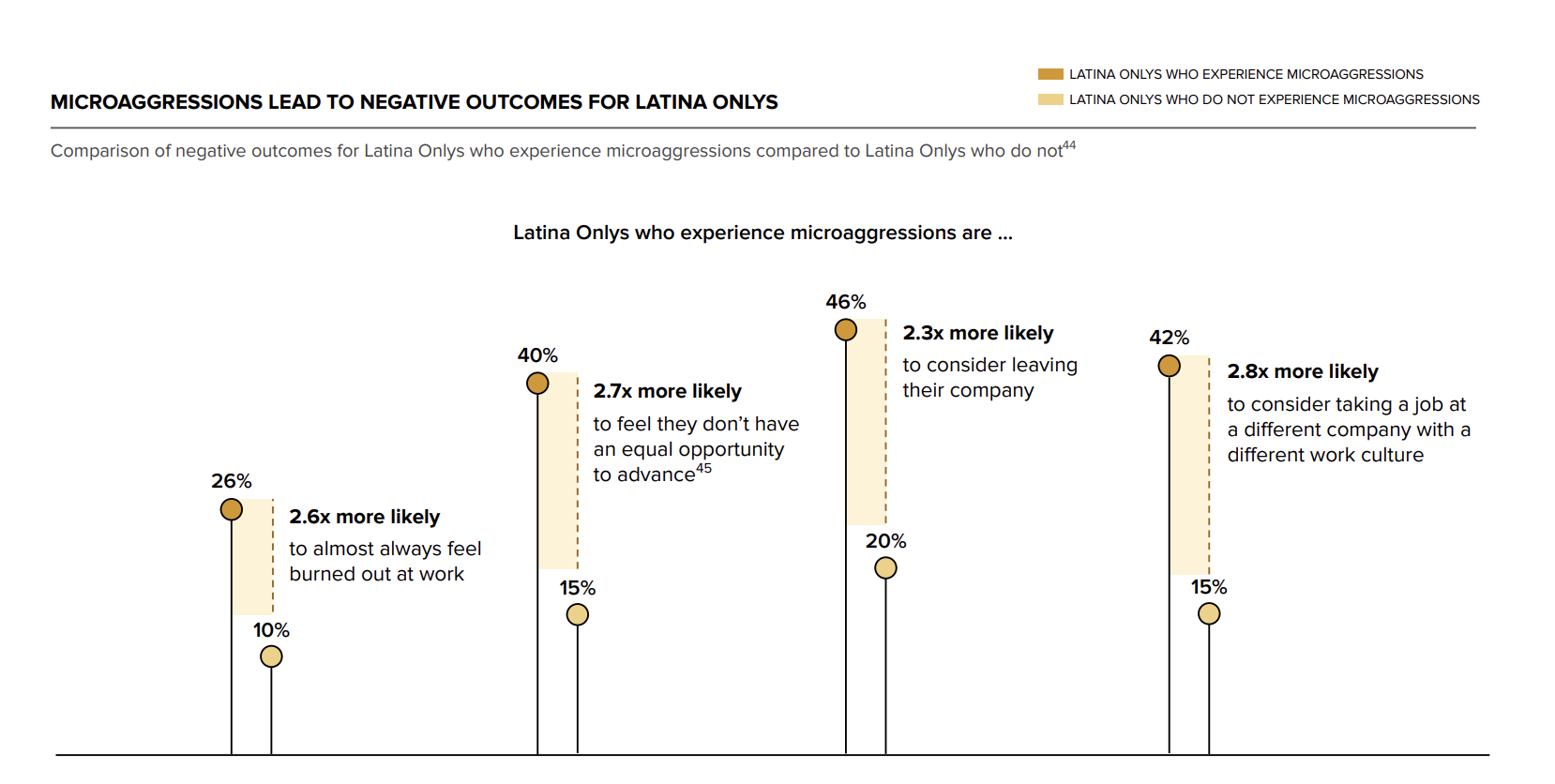
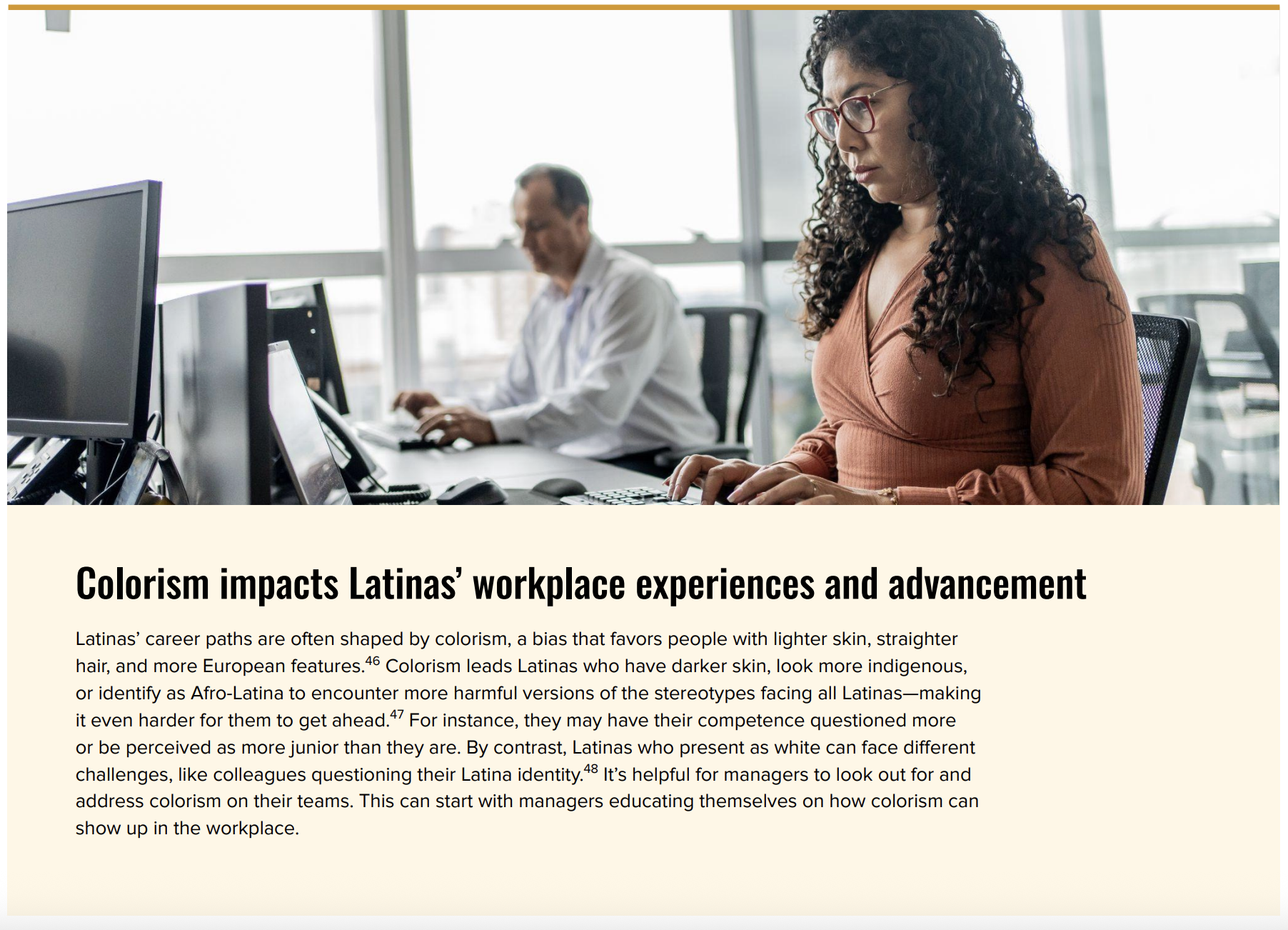
BEYOND THE NUMBERS
Latinas feel pressure to change who they are to succeed at work
For Latinas, bringing their whole selves to work doesn’t always feel like an option. Many report instances where speaking with an accent or wearing a piece of colorful clothing resulted in a microaggression, such as a colleague implying they were unprofessional or mistaking them for someone more junior. One Latina shared that unless she wore “overly professional” clothes to work, she would often be “confused for being the secretary.”To protect themselves and get ahead, Latinas discuss intentionally changing how they present themselves—most often to “blend in” with their white colleagues. “I felt that the only way I could climb the ladder was to do everything I possibly could to assimilate,” shares a Latina executive. “I would watch how the [women] leaders would dress and communicate. I felt I needed to look and sound like that.”While these efforts can help fend off microaggressions, they can also increase burnout and decrease well-being over time.49

From 50 Ways to Fight Bias | How employees can help combat biases women face at work
Microaggressions against Latinas are fueled by stereotypes
HOW IT CAN SHOW UP AT WORK
In a meeting, a colleague says to a Latina, “I can see you’re getting fired up,” when she has been speaking firmly but calmly.
THE BIAS BEHIND IT
Decades of social science research show how stereotypes make the workplace more challenging for Latinas. For example, Latinas can be inaccurately typecast as loud or feisty. This means that when they speak up at work, they may be undermined by being labeled as heated and emotional.50 Employees may feel additionally empowered to criticize Latinas’ demeanor because of stereotypes that link Latinas to lower-status domestic work. As a result, colleagues are more likely to mistake Latinas for someone more junior, give them unsolicited advice on how to look and act, or assign them office housework such as taking notes or making coffee.51
WHAT YOU CAN DO
Speak up in the moment and say you’d like to hear your colleague’s point of view. If you feel comfortable, you can also push back on the suggestion that she’s too emotional or irrational. For instance, you could say, “[Name] doesn’t seem heated to me. I think she’s making some great points.”Go to Lean In’s 50 Ways to Fight Bias Program to learn more.
SECTION 1
Tackle the pipeline barriers that hold Latinas back
Companies would benefit from increasing their focus on advancing Latinas, who face an especially steep path to senior leadership. Here are three ways to get started:53
SECTION 2
Increase the focus on sponsorship for Latinas
Sponsorship accelerates careers.61 But while 3 in 4 companies offer formal mentorship and sponsorship programs, only 1 in 3 Latinas have an active sponsor.62 This gap points to the need for employers to increase Latinas’ access to these programs. For example, companies can survey Latinas to understand what’s getting in the way of participation and then adjust programs as needed. In addition, organizations should make sure leaders and managers understandLatinas’ need for more sponsorship.Since Latinas are less likely to have the senior-level networks that lead to sponsorship, companies should also foster informal sponsor relationships. One way to do this is to stage regular virtual and in-person networking events with the explicit goal of connecting junior- and senior-level employees.In addition to increasing Latinas’ access to sponsors, companies should also take steps to make these relationships as helpful and effective as possible. This can entail training sponsors so they understand the types of support Latinas most need to be successful.63An effective sponsor can hold any identity—what matters is that they have influence and network to advocate for their sponsee.

SECTION 3
Ensure Latinas have equal access to flexibility
As flexible work arrangements become more common, companies need to ensure Latinas get the same access to these options and feel they can take advantage of them. This is especially critical because Latinas may be less comfortable than other employees working in this way.64 Here are three steps to get started:
SECTION 4
Foster inclusion for Latinas
Latinas face day-to-day workplace interactions that can make them feel like outsiders. To counteract this, companies should double down on efforts to foster a true climate of belonging for all employees, Latinas included. Here are three ways to do this:
ADDITIONAL RESOURCES FOR COMPANIES Lean In offers DEI programs used by thousands of organizations worldwide to support and advance women. Lean In Circles combine a world-class leadership curriculum designed specifically for women with the power of small groups coming together to learn and support each other. Our Circles curriculum builds key skills like negotiating and getting the recognition you deserve, and it includes playlists designed for specific identity groups, such as Leadership Fundamentals for Latinas. 50 Ways to Fight Bias training takes the guesswork out of challenging bias. It includes seven in-depth explanations of the workplace biases that Latinas face and offers data-driven recommendations for what to say and do. Allyship at Work empowers all employees to show up as allies for coworkers with less privilege, including Latinas. Find out why organizations like Adidas, Sony Music Group, and Walmart are using our free programs and how you can bring them to your company at leanin.org/partner.